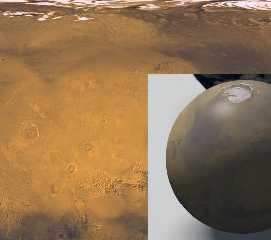|
 |
I've noticed that when I use an image map, the surface is usually very low
contrast and/or low saturation. Is there some setting (i.e. specular -
I've tried turning specular off and it doesn't help) that has an effect
here? How (aside from tweaking the image map) can I fix this?
The attached image shows the image map in the background and a rendering in
the foreground. I've fixed this in the past for backgrounds by using
lightgroups and ambient = 1 for the background image map, but in this case
I need the object with the image map to interact with the light.
Any ideas?
Thanks!
Mike
Code:
#declare mars_tex = texture {
pigment {
image_map {
jpeg "mars_nasa_jpl.jpg" // the file to read
(iff/tga/gif/png/jpeg/tiff/sys)
map_type 1 // 0=planar, 1=spherical, 2=cylindrical, 5=torus
interpolate 2 // 0=none, 1=linear, 2=bilinear, 4=normalized distance
once // for no repetitive tiling
} // image_map
}
finish { // (---surface finish---)
ambient 0.05
specular 0.2 // shiny
roughness 1/100
}
}
light_source {
0*x // light's position (translated below)
color rgb <255, 255, 251>/255 // light's color
area_light
<10*Re, 0, 0> <0, 0, 10*Re> // lights spread out across this distance (x *
z)
20, 20 // total number of lights in grid (4x*4z = 16
lights)
adaptive 2 // 0,1,2,3...
circular // make the shape of the light circular
orient // orient light
translate <5*Re, 10*Re, Re> // <x y z> position of light
}
Post a reply to this message
Attachments:
Download 'mars.jpg' (28 KB)
Preview of image 'mars.jpg'

|
 |
|
 |
"Mike Sobers" <sob### [at] mindspring com> wrote:
> I've noticed that when I use an image map, the surface is usually very low
> contrast and/or low saturation. Is there some setting (i.e. specular -
> I've tried turning specular off and it doesn't help) that has an effect
> here? How (aside from tweaking the image map) can I fix this?
I generally just boost the diffuse value (and also ambient if I'm not using
radiosity). You can also adjust the brightness, contrast & gamma of any
pigment by converting it to a pigment function, and then using an
appropriate transfer function. Jaime's LightSys package can do this sort of
thing.
As you can imagine, this slows rendering, so you're probably better
off tweaking the image file. From the look of your Mars globe, I think you
need to boost the gamma of your source image. Or maybe it's just a funny
JPEG file...
I rendered some globes of Venus & Mars years ago, but the files are still on
my Amiga (I think). com> wrote:
> I've noticed that when I use an image map, the surface is usually very low
> contrast and/or low saturation. Is there some setting (i.e. specular -
> I've tried turning specular off and it doesn't help) that has an effect
> here? How (aside from tweaking the image map) can I fix this?
I generally just boost the diffuse value (and also ambient if I'm not using
radiosity). You can also adjust the brightness, contrast & gamma of any
pigment by converting it to a pigment function, and then using an
appropriate transfer function. Jaime's LightSys package can do this sort of
thing.
As you can imagine, this slows rendering, so you're probably better
off tweaking the image file. From the look of your Mars globe, I think you
need to boost the gamma of your source image. Or maybe it's just a funny
JPEG file...
I rendered some globes of Venus & Mars years ago, but the files are still on
my Amiga (I think).
Post a reply to this message
|
 |




![]()